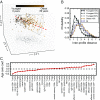Continuous immunotypes describe human immune variation and predict diverse responses
- PMID: 28696306
- PMCID: PMC5544312
- DOI: 10.1073/pnas.1705065114
Continuous immunotypes describe human immune variation and predict diverse responses
Abstract
The immune system consists of many specialized cell populations that communicate with each other to achieve systemic immune responses. Our analyses of various measured immune cell population frequencies in healthy humans and their responses to diverse stimuli show that human immune variation is continuous in nature, rather than characterized by discrete groups of similar individuals. We show that the same three key combinations of immune cell population frequencies can define an individual's immunotype and predict a diverse set of functional responses to cytokine stimulation. We find that, even though interindividual variations in specific cell population frequencies can be large, unrelated individuals of younger age have more homogeneous immunotypes than older individuals. Across age groups, cytomegalovirus seropositive individuals displayed immunotypes characteristic of older individuals. The conceptual framework for defining immunotypes suggested by our results could guide the development of better therapies that appropriately modulate collective immunotypes, rather than individual immune components.
Keywords: aging; human immune variation; immune cell composition; systems immunology.
Conflict of interest statement
The authors declare no conflict of interest.
Figures











Similar articles
-
Longitudinally stable T cell function and innate immune activation distinguish healthy adult immunotypes.Sci Transl Med. 2025 Jun 4;17(801):eadt4605. doi: 10.1126/scitranslmed.adt4605. Epub 2025 Jun 4. Sci Transl Med. 2025. PMID: 40465686
-
Single-cell network profiling of peripheral blood mononuclear cells from healthy donors reveals age- and race-associated differences in immune signaling pathway activation.J Immunol. 2012 Feb 15;188(4):1717-25. doi: 10.4049/jimmunol.1102514. Epub 2012 Jan 13. J Immunol. 2012. PMID: 22246624 Free PMC article.
-
Identification of aging-associated immunotypes and immune stability as indicators of post-vaccination immune activation.Aging Cell. 2022 Oct;21(10):e13703. doi: 10.1111/acel.13703. Epub 2022 Sep 8. Aging Cell. 2022. PMID: 36081314 Free PMC article.
-
Analyzing T-cell responses to cytomegalovirus by cytokine flow cytometry.Hum Immunol. 2004 May;65(5):493-9. doi: 10.1016/j.humimm.2004.02.004. Hum Immunol. 2004. PMID: 15172449 Review.
-
Cytokine flow cytometry: multiparametric approach to immune function analysis.Cytotherapy. 2003;5(1):1-6. doi: 10.1080/14653240310000029. Cytotherapy. 2003. PMID: 12745590 Review.
Cited by
-
Gene Expression Signatures Characterized by Longitudinal Stability and Interindividual Variability Delineate Baseline Phenotypic Groups with Distinct Responses to Immune Stimulation.J Immunol. 2018 Mar 1;200(5):1917-1928. doi: 10.4049/jimmunol.1701099. Epub 2018 Jan 19. J Immunol. 2018. PMID: 29352003 Free PMC article.
-
Naturalizing mouse models for immunology.Nat Immunol. 2021 Feb;22(2):111-117. doi: 10.1038/s41590-020-00857-2. Epub 2021 Jan 25. Nat Immunol. 2021. PMID: 33495644 Review.
-
Systems analysis unravels a common rural-urban gradient in immunological profile, function, and metabolic dependencies.Sci Adv. 2025 May 2;11(18):eadu0419. doi: 10.1126/sciadv.adu0419. Epub 2025 Apr 30. Sci Adv. 2025. PMID: 40305616 Free PMC article.
-
Social association predicts immunological similarity in rewilded mice.bioRxiv [Preprint]. 2023 Mar 16:2023.03.15.532825. doi: 10.1101/2023.03.15.532825. bioRxiv. 2023. Update in: Sci Adv. 2023 Dec 22;9(51):eadh8310. doi: 10.1126/sciadv.adh8310. PMID: 36993264 Free PMC article. Updated. Preprint.
-
Computational Immune Monitoring Reveals Abnormal Double-Negative T Cells Present across Human Tumor Types.Cancer Immunol Res. 2019 Jan;7(1):86-99. doi: 10.1158/2326-6066.CIR-17-0692. Epub 2018 Nov 9. Cancer Immunol Res. 2019. PMID: 30413431 Free PMC article.
References
-
- Bandura DR, et al. Mass cytometry: Technique for real time single cell multitarget immunoassay based on inductively coupled plasma time-of-flight mass spectrometry. Anal Chem. 2009;81:6813–6822. - PubMed
Publication types
MeSH terms
Grants and funding
LinkOut - more resources
Full Text Sources
Other Literature Sources
Medical

